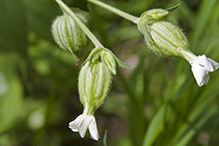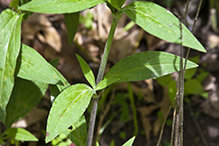white campion
(Silene latifolia ssp. alba)
Conservation • Description • Habitat • Ecology • Use • Distribution • Taxonomy
Conservation Status |
|
|||||||
| IUCN Red List | not listed |
|||||||
| NatureServe | NNA - Not applicable SNA - Not applicable |
|||||||
| Minnesota | not listed |
|||||||
Description |
||
White campion is a 12″ to 40″ tall, erect, occasionally annual, usually biennial or short-lived perennial, forb that rises from a stout, fleshy taproot. When young the plant forms a basal rosette of leaves. Later it sends up flowering stems. The stems are erect or recline on the ground but with the tips ascending. When the plants are uncrowded the stems are branched, when crowded they are branched only near the top. The stems are finely hairy and are covered with minute, short, glandular hairs near the top. There are up to 10 pairs of leaves on the stem. Basal leaves are broad, oblong lance-shaped to elliptic, hairy, and on leaf stalks. They are usually withering by the time the plant is in full flower. Stem leaves are narrower and opposite. They are lance-shaped to elliptic, 1⅛″ to 4¾″ long, less than ¼″ to 1½″ wide, becoming progressively smaller as they ascend the stem. They taper gradually to a pointed tip and are attached to the stem without a leaf stalk. They are hairy on the upper and lower surface. The margins are untoothed and sometimes slightly wavy or crinkled. The inflorescence is open, much-branched cluster in which each axis produces an opposite pair of lateral axes. Each axis pair is subtended by a pair of small, lance-shaped bracts. Male and female flowers are borne on separate plants. Both flowers are ¾″ to 1″ wide when fully open. The sepals are fused at the base into a tube (calyx) terminating in 5 short lobes. The calyx is ⅜″ to 1⅛″ long, prominently veined, and hairy. The veins are often accented with purple. The 5 petals are white, strongly two-lobed, inversely egg-shaped with the attachment at the narrow end, horizontally spreading, with a stalk-like narrow base (claw). The flowers are fragrant. They open in the evening. On male plants the calyx has 10 major veins that are raised on the surface (prominent), forming ridges. The flower is on a short stalk or is nearly stalkless. There are 10 stamens that typically do not project beyond the calyx. On female plants the calyx has 20 major veins, 10 bold and 10 faint, and becomes inflated and egg-shaped, ⅓″ to ⅔″ wide. The flower is on a ⅜″ to 2″ long erect stalk. There are 5 styles that project barely beyond the calyx. The fruit is a green, hairless, egg-shaped capsule the same size as the calyx, with 5 upright teeth (appearing as 10) at the top. |
||
Height |
||
12″ to 40″ |
||
Flower Color |
||
White |
||
Similar Species |
||
Balkan catchfly (Silene csereii) stems and leaves are hairless and glaucous. The stems do not have glandular hairs. The inflorescence has long, raceme-like primary branches. The calyx is smaller, only slightly inflated, and not ridged. It has 10 long and 10 short veins. In male flowers, the stalks of the stamens that support the anthers are purple. Female flowers have 3 styles which are 2 times longer than the calyx. The flowers open during daytime. The fruit has 6 teeth at the top. Bladder campion (Silene vulgaris) stems and leaves are hairless. The stems do not have glandular hairs. Plants either have both male and female flowers or they have female flowers only. The calyx is not ridged. It has 20 obscure, equal veins with a network of veins between them. The calyx the veins are green at first, then become pinkish. Female flowers have 3 styles which are 2 times longer than the calyx. The flowers open during daytime. The fruit has 6 teeth at the top. Drummond’s campion (Silene drummondii var. drummondii) has narrow, ⅜″ wide stem leaves. Night-flowering catchfly (Silene noctiflora) has perfect flowers with both male and female reproductive organs. The calyx is narrow at the mouth and constricted around the base. The flowers have just 3 styles. The fruit has 6 teeth at the top that are bent backwards. Starry campion (Silene stellata) stems are unbranched. The leaves are in whorls of 4. The female flower has just 3 styles. The petals have 4 to 12 frilly lobes. |
||
Habitat |
||
Disturbed sites. |
||
Ecology |
||
Flowering |
||
June to October |
||
Pests and Diseases |
||
|
||
Use |
||
|
||
Distribution |
||||
|
Sources |
|||
| 2/22/2023 | ||||
Nativity |
||||
Native to Asia, Europe, and Northern Africa. Introduced and naturalized in the United States. |
||||
Occurrence |
||||
Common |
||||
Taxonomy |
|||
| Kingdom | Plantae (Plants) | ||
| Division | Tracheophyta (Vascular Plants) | ||
| Subdivision | Spermatophytina (Seed Plants) | ||
| Class | Magnoliopsida (Dicots) | ||
| Subclass | Caryophyllidae | ||
| Superorder | Caryophyllanae | ||
Order |
Caryophyllales (Pinks, Cactuses, and Allies) | ||
Family |
Caryophyllaceae (Pink) | ||
| Subfamily | Caryophylloideae | ||
| Tribe | Sileneae | ||
Genus |
Silene (catchflies) | ||
| Subgenus | Behenantha | ||
| Section | Melandrium | ||
| Species | Silene latifolia (white campion) | ||
Subordinate Taxa |
|||
Five subspecies of white campion have been described. Only one, ssp. alba, occurs in North America. |
|||
Synonyms |
|||
Lychnis alba Lychnis X loveae Lychnis pratensis Lychnis vespertina Melandrium album Silene alba Silene pratensis |
|||
Common Names |
|||
bladder campion bladder-campion evening lychnis white campion white cockle |
|||
Glossary
Bract
Modified leaf at the base of a flower stalk, flower cluster, or inflorescence.
Calyx
The flower cup. May be the group of outer floral leaves (sepals) collectively, or a tube with lobes.
Claw
A stalk-like narrowed base of some petals and sepals.
Glandular hairs
Hairs spread over aerial vegetation that secrete essential oils. The oils act to protect against herbivores and pathogens or, when on a flower part, attract pollinators. The hairs have a sticky or oily feel.


Visitor Videos |
|||
Share your video of this plant. |
|||
| This button not working for you? Simply email us at info@MinnesotaSeasons.com. Attach a video, a YouTube link, or a cloud storage link. |
|||
Other Videos |
|||
| White Campion (Silene latifolia) - 2012-05-05 W3stlander |
|||
About
Published on May 7, 2012 Silene latifolia, or White Campion, is a dioecious flowering plant in the family Caryophyllaceae. ------------------- De avondkoekoeksbloem, witte silene of lijnkruid (Silene latifolia subsp. alba, synoniemen: Melandrium album of Silene pratensis) is een plant uit de anjerfamilie (Caryophyllaceae). |
|||
| White Campion (Silene latifolia) - 2013-06-06 W3stlander |
|||
About
Published on Jun 10, 2013 Silene latifolia (formerly Melandrium album), or White Campion, is a dioecious flowering plant in the family Caryophyllaceae. --------- De avondkoekoeksbloem, witte silene of lijnkruid (Silene latifolia subsp. alba, synoniemen: Melandrium album of Silene pratensis) is een plant uit de anjerfamilie (Caryophyllaceae). |
|||
| White Campion (Silene Latifolia) - 2012-06-07 W3stlander |
|||
About
Published on Jun 11, 2012 Silene latifolia, or White Campion, is a dioecious flowering plant in the family Caryophyllaceae. ----------- De avondkoekoeksbloem, witte silene of lijnkruid (Silene latifolia subsp. alba, synoniemen: Melandrium album of Silene pratensis) is een plant uit de anjerfamilie (Caryophyllaceae). |
|||
| Nightshot of Silene latifolia, hawkmoth and alien. Markus Jerominek |
|||
About
Uploaded on Jul 3, 2008 pollination of silene latifolia by a hawkmoth. After pollination an incect comes around, that i don´t know. Maybe it´s an parasite of the hawkmoth. |
|||


|
Created: Last Updated: © MinnesotaSeasons.com. All rights reserved. |
















